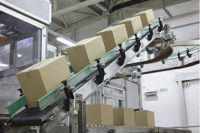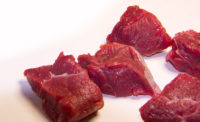Advancements are occurring with conveyors and belting for processors aiding in sanitation and longevity of the systems. For example, newly designed conveyors have removed flat surfaces, says Jeff Evers, Butterball’s plant maintenance manager for its Mount Olive, N.C.-facility. Additionally, components are designed from solid materials, and angled edges and open sides are features. Solid sealed roller drive systems, where applicable, remove the side weight of gearbox and motor combinations to reduce breakdown change-out timeframes at failure points as well.
Belt design improvements are all about the pin and hinge combination, Evers says. For example, belt design improvements consider whether it can be opened to gain access for easier cleaning and the type of pin used versus the type of belting materials.
“Today’s companies have to fully understand all aspects of operations, sanitation and maintenance for the use and not be one-dimensional,” Evers says. “All aspects have to be considered when determining the correct conveyer design and correct belt to purchase.”
Still, processors are facing issues with cleaning conveyors. Niche points on the framework, belt tensioner systems, as well the belting on hinge/pin conveyor systems, are some of the biggest challenges when it comes to cleaning, Evers says. “These areas of conveyor systems build up proteins that require scrubbing action to remove them,” he says.
Conveyor manufacturing groups have designed internal spray bar systems and belt lifting systems that are built into the conveyor to gain access under the belting though. These can be purchased and installed on existing conveyors or ordered on newly designed systems. In addition, belting manufactures are improving the design of hinge/pinned conveyor systems with wider openings at the hinge point to improve accessibility during the cleaning process, Evers says.
Many people consider maintenance of conveyors to be simple. For example, grease the bearings and check the pins on the belt, guides and wear strips and maintenance is done. Now the opportunity exists to purchase the right design up front, Evers says.
“Conveyors utilizing the drum roller motor system can be designed without bearings that require weekly greasing, reducing the total preventive maintenance time by having fewer components and quick change mounting brackets reduce overall downtime of the system,” he explains. “This also removes foreign material risk.”
Certain applications for conveyor will require the motor/gearbox design to handle the load capacity of the products’ run. “With that style, more mechanical time and preventive steps to assure the system will operate as designed is required, and a more in depth preventive maintenance SOP [standard operating procedure] is required to verify condition and wear,” Evers says.
A big demand on conveyors is dependability of the asset, giving processors confidence the systems will run as designed on a daily basis.
“Systems need to operate without downtime for early failed components and without creating foreign material hazard since conveyors are designed to move products — raw, cooked, packaged, boxed, etc.,” Evers says. “Conveyors are a necessary link between phases of many processes, and if they don’t function as designed, it stops the process.”
Moving forward, friction and wear will remain the biggest challenges equipment manufacturers face with conveyors.
“With a solid stationary surface like guide rails or support rails and a moving belt of a variety of material makeups, friction and wear is ever present,” Evers says. “Minimizing this is key going forward in addition to minimizing foreign material potentials and minimizing the number of components that can fail.”
Longevity of today’s conveying systems speaks to the quality of current conveyor engineering.
“Having been in the industry for 32 years, I’ve seen conveyor and belting designs improve to the point where they are only changed out when the full process changes or a new product is developed that requires a completely different design,” Evers says. NP





Report Abusive Comment